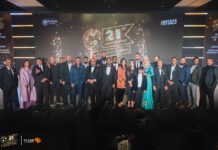 Naeem Arif is a highly experienced customer-orientated leader, with over 15 years experience as director of multiple successful Private Limited Companies in the Retail and Management Consulting world. He the founder of NA Consulting, a retail and management consultancy, and the Co-Founder and Vice Chair of the Midlands Retail Forum.
Naeem Arif is a highly experienced customer-orientated leader, with over 15 years experience as director of multiple successful Private Limited Companies in the Retail and Management Consulting world. He the founder of NA Consulting, a retail and management consultancy, and the Co-Founder and Vice Chair of the Midlands Retail Forum.
With high levels of competition and the explosion of demand for prepared food, technology has presented as the key for enabling brands and independents to stand out from the crowed.
Over the last decade there has been an unprecedented growth in the entire foodservice industry but particularly with restaurant. Low food crops and an increase in disposable income have created an opportunity for the development of many exciting and attractive restaurant concepts with the aim to engage in Flyers on the fact that more and more people are eating out more than ever. In response to the increased appetite of consumers the European market has rapidly expanded changed with a mixture of existing brands expanding and refurbishing, new brands being created, independent operators influence appendices brands undertaking international expansion has expanded the foodservice sector. From the quick service restaurants and street food vendors one end to fine dining at the other, everything else in between. The UK alone has around 60% of the market is comprised of small restaurant and Gastro pubs. In parts of continental Europe such as Turkey and Greece, that percentage is even higher creating greater competition and the need for engagement and the differentiation.
Compete by Digitising
In order for restaurants to compete in such a booming growing space as well as remaining relevant and appealing to the next generation of younger more tech savvy diners restaurants are embarking widespread refurbishment of the outlets, including overhauling the interaction presentation process. These diners want more digital autonomous interactive entertaining and self-determined dining and ordering experience. For all restaurants there is need and opportunity for them to live its new display projection technologies to update the outlets improve visual communication create more dynamic adaptive customer information service points.
Take into consideration the world’s largest QSR brands, they have undertaken a broad update of decor and soft furnishings in the last decade and am now rolling out a variety of digital display technologies to update the one remaining legacy customer experience – point of sale. It is an important time to undertake this update and renewal with any USR brands experiencing wants widespread change not just to the décor and clientele but also to menu options. Restaurants are embracing everything from organic detailed provenance of produce. This means there is greater detail about menu items to express to customers.
There are various points around restaurants with these transformations are taking place better than the benefits offerings from the wholesale digitalisation of restaurant POS at every level.
Coping with time sensitive menus
Focusing on quick service restaurants although trading is normal, the challenge of presenting different managed to customers at different points of the day breakfast lunch and dinner or late-night has traditionally involve rotating printing display boards or swapping out posters menu cards. This is a time-consuming process involving paper and poster stock that deteriorates over time, not to mention the mistakes which are expensive and time-consuming to correct. The introduction of 1080p and 4K Ultra high-definition display technologies combined with low cost and low profile computers and video display devices have replaced the revolving above counter displays and wall mounted menus. The evolution of almost bezel-less 40inch+ high resolution display units means that the same high quality of image and clarity of text offered by printed poster can now be achieved on a digital display. The removal of rotating displays and poster boards also eliminate potential hygiene risks as well as well as health and safety flashpoints from the restaurant, with rotating displays presenting as a bacterial transfer point if not meticulously cleaned and maintained. Also, the high position of rotating displays above customers often requires the use of the step ladder for the tool to enable reach creating heightened safety risks, digital displays however require no physical contact update immediately remove all these factors from operational risk assessments. At the same time printing and transporting costs of the stock paper posters and menus are also eliminated contributing to improve return on investment (ROI).
Self-service by touch
alongside modernising and digitising customer information displays, large format, high resolution displays also present another major advantage to restaurants, this is self-service QSR’s already tap into the self-service space by dispensing with the tablet service in most instances. However, using large touch-driven displays it is now possible to create a customer friendly, interactive and data rich self-ordering process. This process not only allows for an overall reduction in sales staff costs is, but also allows for the redeployment of staff from the cash register to the food preparation, customer service and counter fulfilment. You this can improve connectivity, reduce order wait times for customers and reduce mistakes during the order process as well as a further improvement to customer experience stop touchscreen is not only provide a visual and interactive ordering experience: they also facilitate automated and smart upside down cross selling ordering systems can respond to audit items to suggest additional purchases, or cover average and no customers purchase history into conjunction with the loyalty cards NFC recognition or other unique identifiers. Knowing the customer is nothing new but in a digital POS environment there is more scope for the average customer relationship and build a more detailed digital profile, as well as gaining broader analytics for the business around 12 times, most of the items, abandon baskets etc.
Spot promotions
digital displays allow customers to cycle through the different menu options based on the time of day, when you can also be updated essentially with new prices on products are introduced full digitalisation of these POS positions enable the possibility for restaurants to customise. For example, background colour changes, brightness and contrast settings to suit a particular locations to call a natural lighting, addition of local specials, localised pricing to respond to local competition, special events and other spot promotions. There is also potential to re-purpose or multipurpose digital displays, with some screens be used for promotional the poster displays during the day because later on be used to show music videos or sporting events in the evening to entertain a different style customer entertainment potential of modern-day displays and projection technology cannot be underestimated, re-purpose displays at different times for entertainment purposes can help create a different ambiance, such as children’s programming, music videos, sports, news and targeted advertising and restaurant specific television programming. This may also attract different clientele as you restaurants move from breakfast to lunch and dinner services. Since display and motion sensitive units also allow other family friendly entertainment options including gaming or verification of ordering as well as enabling art installations.
The use of advance and announced the technology is helping operators create more flexible and customer centric learning environments, with customers looking for a new and more exciting dining experience. Embracing what digital offers real-time foodservice sector restaurants have the opportunity to present diners with a more vibrant and interactive ordering process as well as adding to the décor and ambience of the venue.





































